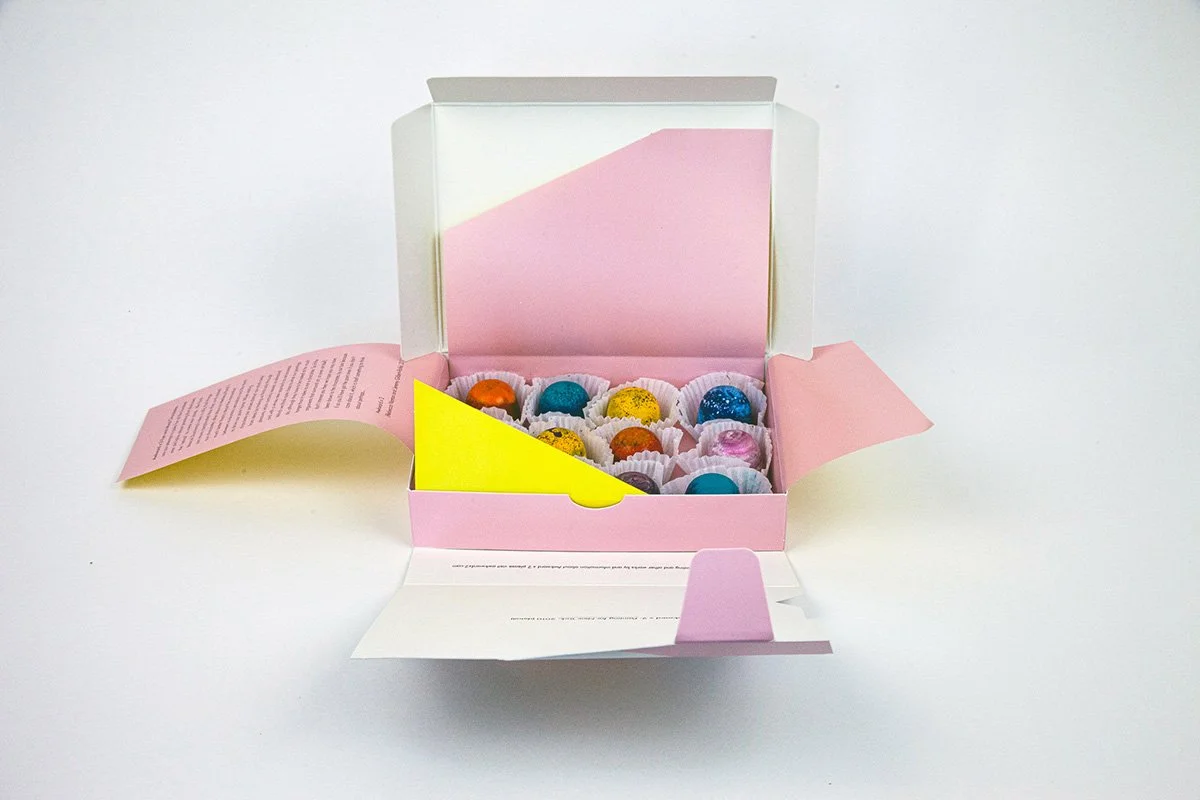Chocolate Box
Awkward x 2 (Rebecca Norton and Jeremy Gilbert-Rolfe), Chocolate Box, 2011
By Lilly Wei
“Phenomenology,” JGR said.
“What?” LW replied.
So.
A package arrives via FedEx. Opening it, I discover a box and open that too. Inside it is another box. This second box is pink, a trending Barbie Land pink, say, or a less trending Boucher pink, or (even better) a melt-in-your mouth Ladurée macaron pink. What seems to be the detail of a geometric painting is imprinted on its lid, one edge of which is excised, the cut in the form of a smallish triangle. The box nestles comfortably within the cradle made by the palms of my two outstretched hands as I weigh it, trying to guess what might be inside, shaking it a little. My outstretched palms are also, it seems to me, a timeless gesture of supplication (terribly much too much in evidence these days) that, by turning them inward and steepling the fingers (a transition that is effortless) becomes one of gratitude. But since I don’t know what it is, I’m not grateful yet.
The painting is a series of slivered geometric shapes mostly on a diagonal that suggest a shattered prism (metaphor?). The pastel color scheme, its preference for pinks foretold, is anchored by a cluster of dark shards on one side that is countered by a strategically placed array of whites throughout that imply space, light. The folded-over flap that secures the lid is also cut along an angle with a tab. I try to puzzle out how to open it without tearing it apart, intentional, no doubt, on the part of the artists to encourage us to focus on the box’s construction and content, to participate, to prolong the experience: a ritardando, rallentando—slow art.
Coaxing the tab carefully out of its slot, the interior of this lid discloses the caption information for the (yes) reproduced painting: Awkward x 2’s Painting for New York (2010) (detail) signed by the two artists, Jeremy Gilbert-Rolfe and Rebecca Norton. Encountering another pink lid fitted into the box, I carefully lift that one up too. Printed on its inner surface, centered, is this: “Awkward x 3 Eye and Mind Chocolates are a joint production of Awkward x 2 and Snake and Butterfly.” Ah, a (rather telling) clue.
But there is yet another layer, this one of coated paper, yellow on the obverse, the same beguiling pink on the reverse, cut into four flaps like the shapes in the painting, folded over each other. I lift the flaps one by one; all is revealed at last: (real) chocolates. They are arranged in a tray that is sectioned into a (modernist?) grid, each piece snugly bedded in its individual compartment. The chocolates are plump, temptingly aromatic, handcrafted, of different colors, brushed with expressionistic swirls, evoking worlds in miniature, the cosmos in a box, the ineffable transubstantiated as—chocolate.
But wait. There is more text on one of the coated flaps. To quote from it, the two artists declare that their project is an “attempt to poke fun at the hundred-year-old fable about painting that dismisses the ‘retinal’ as mere eye candy…naming our candy after Maurice Merleau-Ponty’s much better theory about the connection between involuntary sensations and the mind to drive our point home.” (The essay “Eye and Mind” is one of the philosopher’s last, considered by Sartre to be Merleau-Ponty’s most complete statement).
Merleau-Ponty did not isolate experience. Our bodies exist in space, with other bodies and other things, not in isolation from them, not solely as mind, as ideation, and synesthesia is not necessarily an anomalous condition, a confusion. We are mind and matter, sense and sensation, a series of interconnected reactions, responses, perceptions, based on the tangible and what is not, on the friction between the real and the imagined, which is a more complete and representative state of being, a more generous, affirmative immersion into the world, into existence. It makes a case for civility, attentiveness, for taking what joy we can in the face of so much that isn’t.
Pleasure is affirmative although it does not preclude seriousness, the artists remind us (except perhaps here where the purely aesthetic is often considered too mandarin, suspect, rubbing against America’s self-proclaimed egalitarian, utilitarian grain.) Paint and chocolate: both are sensuous, seductive, to be savored and enjoyed as luxuries that are also (arguably) essential. (The artists point out that the time to eat a morsel of chocolate is far less than the time it takes to look at a painting although they might be unduly optimistic in that assumption since often, (perhaps most often, both art and chocolate, and most everything else, are all too quickly consumed—although with different consequences.)
They conclude, “if the arguments that surround art, or even art itself, don’t interest you then we hope you may have been drawn to the chocolates by our box because if so you’ll have got the point…”
And so.
Reader, I ate them. They were phenomenal! (And am considering what to do with the pretty box.) Did I get the point?
